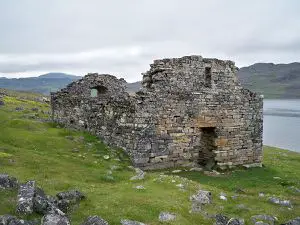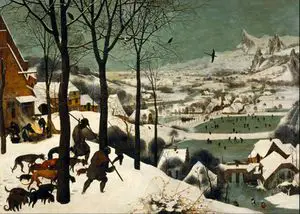How did climate change influence Medieval and Early Modern Europe
Our changing climate shows many examples where it altered and shaped history. Climate is not a deterministic process, but it does create the conditions that forces people to adjust their lives. This leads to societies and cultures that adapt or reflect the climatic conditions prevalent in an area. In Europe, we see changing opportunities and challenges for Medieval and Early Modern European societies as the climate changed.
Early Medieval Europe and Climate
Soon after the fall of the Roman Empire and the emergence of early European kingdoms and societies, the climate during this time mostly appeared to be colder and wetter than conditions today. River floods were more intense during the 500-600s. Between 500-900 CE, glaciers were expanding in the Alps and other northern regions of Europe such as Scandinavia. In northern Europe, agriculture was often on the margins, where crops can be grown in what today would be a typical year during the summer months.
However, the increased persistence of cloudy weather, a large amount of rain, and generally colder conditions could lead to increased crop failures during the summer months in the earliest phases of the Medieval period. This change has led some scholars to believe at least some of the Norse and Dane movements, which we call the Vikings, that occurred by the 8th century occurred due to these cooler conditions. It just became more difficult for agriculture to be successful in the northern regions of Europe, leading to increased dependence on raiding or settling new lands that were more productive.
In fact, from the 8th to 9th centuries, Viking raids and the eventual settlement became more intense, suggesting conditions may have become harsher leading to more bold movements. During this time, large waves of Vikings landed in Europe, including in France, Britain, and areas south of Denmark. Some Viking travelers went even further into Russia and Mediterranean regions, taking the enormous risk but such risk may have been considered in light of the situation back in northern Europe.[1]
While cooler conditions may have forced some migrations to occur in the early Medieval period that forever shaped the history of regions such as Britain and France, at around 950-1250 CE, the climate began to take a warmer turn. This period is known for population increases. Cities and trade began to flourish at a greater rate in this period. Wine was even made in northern Europe. For the first time since the Roman period, the population in cities began to thrive.[2]
Areas previously not inhibited significantly, such as Greenland, now became an area for long-lived Norse colonies during what was called the Medieval Warm Period. Famous Norse explorers such as Erik the Red in the late 10th century named Greenland as such because they wanted to convince others that it was a good area to settle. The warming climate made the story somewhat believable and enabled the Norse to settle different areas of Greenland (Figure 1). Climate studies have suggested conditions may have been warmer at this time than even modern conditions or perhaps conditions were similar.
Erik the Red and his descendants, including Lief Leif Erikson, visited lands they called the land of forests and land of wine, which could have been about North America such as areas in Labrador and Newfoundland. The settlement of L'Anse aux Meadows, in Newfoundland, represents the clearest evidence of Norse settlement in North America. The Norse also began to trade with Native American groups such as the Beothuk and Thule. All of these long-distance travels in regions that have been frozen over in recent history suggest much warmer conditions made these travels possible or certainly easier. However, by around 1400 things seemed to have died out and the Norse abandoned settlements in Greenland and North America. Once again, conditions became cooler in the higher latitudes.[3]
Late Medieval and Early Modern Europe and Climate
In the 1300s-1500s, the climate was somewhat stable, but colder conditions began to become evident. This though did mean many of the settlements became harder to continue in regions such as Greenland. Winemaking began to retreat southward to central and southern Europe. Populations did recover and expand after the Black Death of the 14th century, in part, this was helped by the favorable climate conditions in the 14th century. Climate events elsewhere in Asia may have triggered the Black Death itself. By the 16th century, it became even more decisively colder. The so-called Little Ice Age began around the 14th century and continued well until the 19th century at around 1850, resulting in about 550 years of generally colder conditions. Prolonged colder conditions began to lead to more crop failures as well as increased rates of disease.
This cooling may have contributed to some of the peasant revolts and increased activities of rebellion that gradually reduced the power of the nobility and gave greater power and freedom to the lower classes that is evident in late Medieval Europe. Another result of this period was the association between witchcraft and weather-making. From the late 14th century and through the Little Ice Age, witchcraft became a significant accusation and increasingly used in Europe, with women in particular targeted with accusations. Witchcraft soon became associated with the power to shift the climate and the fact that rivers froze and crops failed led these accusations to become more common. Marginalized groups, such as Jewish communities, were also sometimes blamed for the turn in the climate.[4]
There were other cultural responses. In the 16th century, artists began to use winter and winter-like scenes in their paintings increasingly. This was relatively rare before this period. The use of clouds and winter scenes appears to have peaked between 1600-1649 in paintings, which may have been among the coldest parts of this period (Figure 2). Ice skating began to become a popular sport in many regions of Europe. From 1608-1814, London had a Frost Fair that included ice skating on the Thames and other winter activities. The fact that rivers froze deep enough to enable prolonged periods of ice skating had not occurred before. The fact it has also not existed since the 19th century indicates conditions have become warmer since then.
In Scotland, it is likely curling became a popular sport during the Little Ice age, as long periods of frozen weather enabled this sport to be played for a long period of the year. By around the mid 19th century, the climate began to take a clear warming trend, resulting in temperate conditions once again returning to many parts of Europe.[5]
Conflict and Climate
Perhaps two great conflicts were affected by the Little Ice Age. The first is the Thirty Years War, arguably Europe's most devastating religious war, which lasted between 1618-1648. This period saw extraordinary amounts of strife and religious wars between Protestants and Catholics in Germany, France, Northern Europe, and other regions across Europe were also affected by inter-community and state-level strife.
This outbreak of violence changed the course of European history by altering the religious makeup of the continent and weakening the Catholic Church in much of Northern Europe. It also helped lead to the rise of France as a major power. This was also was partly triggered by increasing crop failures and civil strife caused by climatic events that led to inter-community tensions that pushed the different sides into conflict.[6]
The second great conflict in this time was the French Revolution. In the late 18th century, increasing crop failures led to the peasants struggling to pay their taxes to the wealthy landlords and nobles of France. Soon, the population became fed up with their high taxes and poor harvests. As the revolutionary cause gained greater appeal, French authorities struggled to contain mass riots. Eventually, these riots culminated with the storming of the Bastille and Louis the XIII as overthrow. A period of bloody conflict followed that eventually led to the rise of Napoleon. In large part, discontent that was created in this period was linked with climatic events that shaped the continent in the late 18th century that led to the fall of the French monarchy and rise of the Napoleonic Age.[7]
Summary
We can see that climate played an important role in shaping cultures in the region as well as how cultures expressed themselves. From the early Norse explorers who traveled distant regions to the French revolutionaries who overthrew their monarchy, climate played some role affecting these events. Climate was certainly not the only reason these events happened but it played a role as a key context in shaping events. The cultural change also happened in the arts and even sports in part due to climate, where climate events influenced ice skating and paintings. While this has occurred in the recent past, we should perhaps expect the same in the coming ages of Europe and other Western societies.
References
- ↑ For more on the Viking and Norse movements and raids as a result of climatic events, see: Lieberman, B. D., & Gordon, E. (2018). Climate change in human history: prehistory to the present. London ; New York: Bloomsbury Academic, an imprint of Bloomsbury Publishing Plc.
- ↑ For more on cities in Europe in the early Medieval period and how they began to thrive again, see: Scott, T. (2012). The city-state in Europe, 1000-1600: hinterland, territory, region. Oxford ; New York: Oxford University Press.
- ↑ For more on the Medieval Warm Period and the Norse explorations, see: Hopkins, A., & Hopkins, A. (2002). Vikings: the Norse discovery of America (1st ed). New York: PowerKids Press.
- ↑ For more on the Little Ice Age and its effect in Europe, see: Fagan, B. M. (2002). The little ice age: how climate made history 1300-1850 (1st. paperback ed. 2002). New York: BasicBooks.
- ↑ For more on how the culture was affected by the Little Ice Age, see: Behringer, W. (2010). A cultural history of climate. Cambridge, UK ; Malden, MA: Polity.
- ↑ For more on the Thirty Years War and conflict that may have been influenced by a colder climate, see: Helfferich, T., & Helfferich, T. (Eds.). (2015). The essential Thirty Years War: a documentary history . Indianapolis: Hackett Publishing Company, Inc.
- ↑ For more on the French Revolution and crop failures as a contributor to the events, see: Jones, P. (1988). The peasantry in the French Revolution. Cambridge [Cambridgeshire] ; New York: Cambridge University Press.

